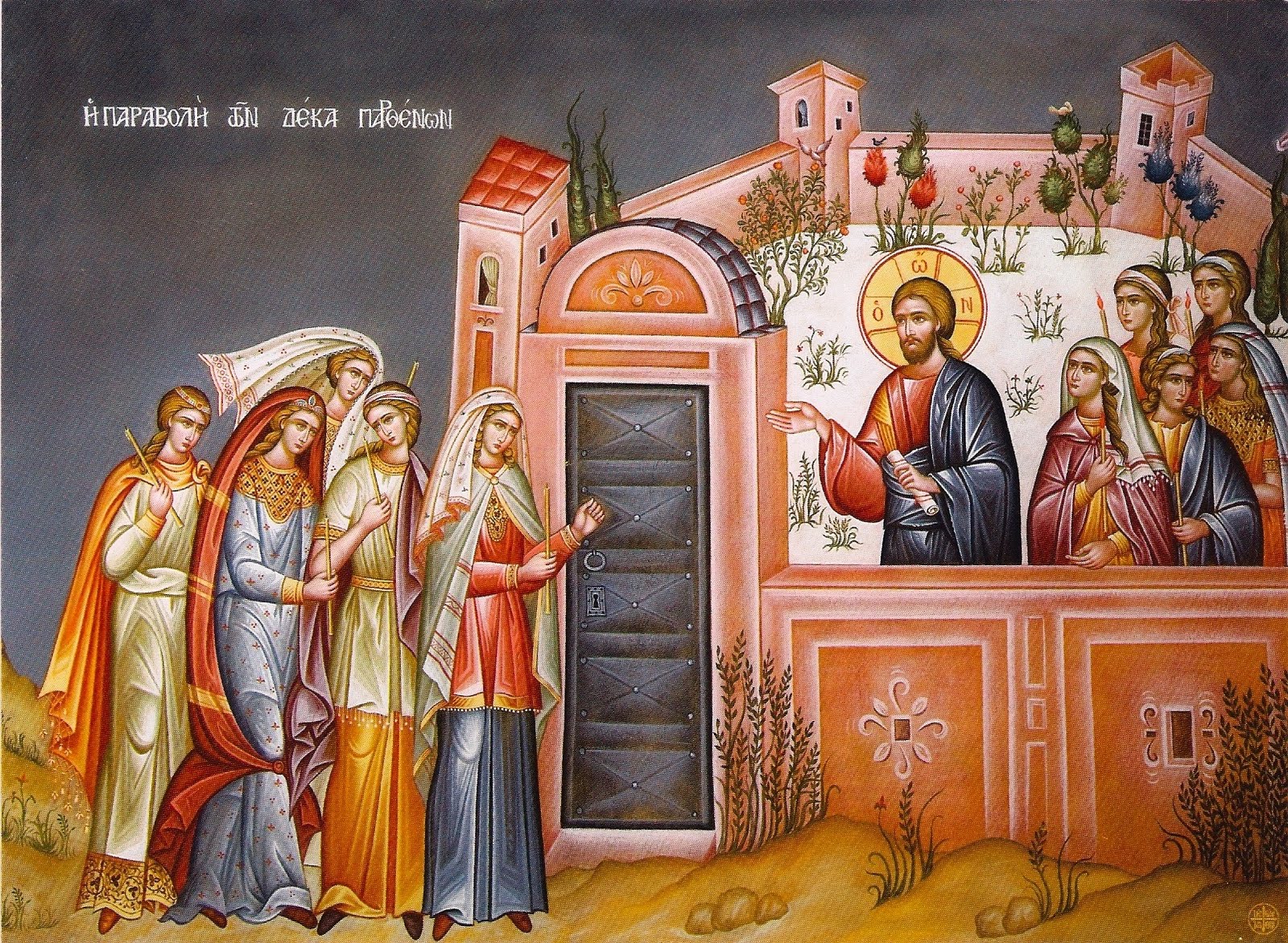GREAT AND HOLY TUESDAY. Watch therefore, for ye know neither the day nor the hour wherein the Son of man cometh. Matthew 24:13
On Monday evening, Jesus Christ also tarried in Bethany, and on Tuesday morning he again came to the temple in Jerusalem and taught much in the both inside and outside the temple (Mt. 21:1). The high priests and elders heard His parables and understood that He was talking about them, and so they tried to catch Him and kill Him. However, they were afraid to take Him openly because the people revered Him as a prophet (Mt. 21:46) and were astonished at His doctrine (Mk. 11:18) and heard Him gladly (Mk. 12:37).
On this day, the Church has chosen as foremost from the Gospel teachings of Christ the parable of the ten virgins, particularly appropriate for the period of Holy Week, during which we should be especially vigilant and in prayer. Through the parable of the ten virgins the Church is urging us to be always ready to meet the Heavenly Bridegroom with chastity, almsgiving, and the urgent practice of all the other virtues, which are represented by the oil prepared by the wise virgins.
In the Eastern Orthodox Church, Armenian Apostolic Church and those Eastern Catholic Churches that follow the Byzantine Rite, this day is referred to as Great and Holy Tuesday, or Great Tuesday. On this day the Church commemorates the Parable of the Ten Virgins (Matthew 25:1-13), which forms one of the themes of the first three days of Holy Week, with its teaching about vigilance, and Christ as the Bridegroom. The bridal chamber is used as a symbol not only of the Tomb of Christ, but also of the blessed state of the saved on the Day of Judgement. The theme of the Parable of the Talents (Matthew 25:14-30) is also developed in the hymns of this day.
The day begins liturgically with Vespers on the afternoon of Great Monday, repeating some of the same stichera (hymns) from the night before. At Great Commpline a triode (Canon composed of three Odes), written by St. Andrew of Crete is chanted.
The Matins service for Monday through Wednesday of Holy Week is known as the Bridegroom Service or Bridegroom Prayer, because of their theme of Christ as the Bridegroom of the Church, a theme movingly expressed in the troparion that is solemnly chanted during them. On these days, an icon of "Christ the Bridegroom" is placed on an analogion in the center of the temple, portraying Jesus wearing the purple robe of mockery and crowned with a crown of thorns (see Instruments of the Passion). These Matins services are often chanted the evening before so more of the faithful may attend. The Matins Gospel read on this day is from the Gospel of Matthew 22:15-23:39.
Μεγάλη Τρίτη: "Η ἐν πολλαῖς ἁμαρτίαις περιπεσοῦσα γυνή"
Tρίτη ημέρα της Μεγάλης Εβδομάδας, της Εβδομάδας των Παθών, η Μεγάλη και Αγία Τρίτη.
Τούτη την ημέρα ενθυμούμαστε την παραβολή των δέκα παρθένων και την παραβολή των ταλάντων. Οι παραβολές αυτές μας καλούν να καλλιεργήσουμε τις αρετές οι οποίες θα μας εντάξουν στη Βασιλεία των Ουρανών. Αρετές όπως η εργατικότητα, η προνοητικότητα και η ετοιμότητα.
Παραβολή των δέκα παρθένων: Γρηγορεῖτε οὖν, ὅτι οὐκ οἴδατε τὴν ἡμέραν οὐδὲ τὴν ὥραν ἐν ᾗ ὁ υἱὸς τοῦ ἀνθρώπου ἔρχεται.
Κατά τη Δευτέρα Παρουσία, η Βασιλεία των Ουρανών θα μοιάσει με δέκα κοπέλες (παρθένες), που πήραν τα λυχνάρια τους και βγήκαν να προϋπαντήσουν τον Κύριο. Από αυτές, οι πέντε ήταν συνετές και οι άλλες πέντε μωρές. Οι ανόητες, σε αντίθεση με τις συνετές, όταν πήραν τα λυχνάρια τους, δεν πήραν μαζί τους λάδι. Επειδή αργούσε ο Νυμφίος, νύσταξαν όλες και κοιμόνταν. Κατά τα μεσάνυχτα, ακούστηκε ισχυρή φωνή: "Ιδού ο Νυμφίος έρχεται! Βγείτε να τον προϋπαντήσετε!". Οι πέντε φρόνιμες, πήραν τα λυχνάρια τους και πρόλαβαν τον Κύριο και τις πύλες ανοιχτές. Οι μωρές, όταν κατάφεραν να βρουν λάδι για τα λυχνάρια τους, βρήκαν τις πύλες κλειστές και παρέμειναν εκτός.
Παραβολή των ταλάντων: Τώ γάρ έχοντι παντί δοθήσεται και περισσευθήσεται· από δε τού μη έχοντος και ό έχει αρθήσεται απ' αυτού.
Ήταν ένας άρχοντας ο οποίος ετοίμασε μακρινό ταξίδι, έτσι αποφάσισε να μοιράσει οκτώ τάλαντα σε τρεις δούλους του. Στον πρώτο έδωσε πέντε, στο δεύτερο δύο και στον τρίτο ένα τάλαντο.
Όταν ο άρχοντας επέστρεψε, οι δούλοι έπρεπε να ενημερώσουν τον αφέντη τους για το πως αξιοποίησαν τα χρήματα που τους έδωσε.
Ο δούλος που πήρε πέντε τάλαντα επέστρεψε δέκα, αυτός που πήρε δύο επέστρεψε τέσσερα και τέλος, αυτός που πήρε ένα, θεώρησε ότι ο άρχοντας του φέρθηκε σκληρά και ήταν άδικο να περιμένει περισσότερα, κι έτσι επέστρεψε ένα τάλαντο.
Τότε ο άρχοντας διέταξε να του το πάρουν και να τον τιμωρήσουν.

The icon is very beautiful.
Thank you very much! God have mercy on us all!